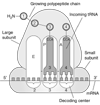Toward an understanding of the structural basis of translation
- PMID: 14659007
- PMCID: PMC329409
- DOI: 10.1186/gb-2003-4-12-237
Toward an understanding of the structural basis of translation
Abstract
The recently solved X-ray crystal structures of the ribosome have provided opportunities for studying the molecular basis of translation with a variety of methods including cryo-electron microscopy - where maps give the first glimpses of ribosomal evolution - and fluorescence spectroscopy techniques.
Figures




Similar articles
-
[The structural changes in the ribosome during the elongation cycle].Mol Biol (Mosk). 2006 Sep-Oct;40(5):755-68. Mol Biol (Mosk). 2006. PMID: 17086976 Review. Russian.
-
Structure of the decoding center of the ribosome.Biochemistry (Mosc). 1998 Aug;63(8):963-76. Biochemistry (Mosc). 1998. PMID: 9767188
-
The ribosome-structure and functional ligand-binding experiments using cryo-electron microscopy.J Struct Biol. 1998 Dec 15;124(2-3):142-50. doi: 10.1006/jsbi.1998.4071. J Struct Biol. 1998. PMID: 10049802
-
The structure and function of the eukaryotic ribosome.Cold Spring Harb Perspect Biol. 2012 May 1;4(5):a011536. doi: 10.1101/cshperspect.a011536. Cold Spring Harb Perspect Biol. 2012. PMID: 22550233 Free PMC article. Review.
-
High-resolution cryo-electron microscopy structure of the Trypanosoma brucei ribosome.Nature. 2013 Feb 21;494(7437):385-9. doi: 10.1038/nature11872. Epub 2013 Feb 10. Nature. 2013. PMID: 23395961 Free PMC article.
Cited by
-
Binding properties of YjeQ (RsgA), RbfA, RimM and Era to assembly intermediates of the 30S subunit.Nucleic Acids Res. 2016 Nov 16;44(20):9918-9932. doi: 10.1093/nar/gkw613. Epub 2016 Jul 5. Nucleic Acids Res. 2016. PMID: 27382067 Free PMC article.
-
Near-atomic resolution using electron cryomicroscopy and single-particle reconstruction.Proc Natl Acad Sci U S A. 2008 Feb 12;105(6):1867-72. doi: 10.1073/pnas.0711623105. Epub 2008 Jan 31. Proc Natl Acad Sci U S A. 2008. PMID: 18238898 Free PMC article.
-
The structure of the 80S ribosome from Trypanosoma cruzi reveals unique rRNA components.Proc Natl Acad Sci U S A. 2005 Jul 19;102(29):10206-11. doi: 10.1073/pnas.0500926102. Epub 2005 Jul 12. Proc Natl Acad Sci U S A. 2005. PMID: 16014419 Free PMC article.
-
A method for the alignment of heterogeneous macromolecules from electron microscopy.J Struct Biol. 2009 Apr;166(1):67-78. doi: 10.1016/j.jsb.2008.12.008. Epub 2008 Dec 30. J Struct Biol. 2009. PMID: 19166941 Free PMC article.
-
Understanding ribosome assembly: the structure of in vivo assembled immature 30S subunits revealed by cryo-electron microscopy.RNA. 2011 Apr;17(4):697-709. doi: 10.1261/rna.2509811. Epub 2011 Feb 8. RNA. 2011. PMID: 21303937 Free PMC article.
References
-
- Spirin AS. Ribosomes. New York: Kluwer Academic/Plenum Publishers; 1999.
-
- Huxley HE, Zubay G. Electron microscope observations on the structure of microsomal particles from Escherichia coli. J Mol Biol. 1960;2:10–18.
-
- Stark H, Mueller F, Orlova EV, Schatz M, Dube P, Erdemir T, Zemlin F, Brimacombe R, van Heel M. The 70S Escherichia coli ribosome at 23 Å resolution: fitting the ribosomal RNA. Structure. 1995;3:815–821. - PubMed
-
- Agrawal RK, Penczek P, Grassucci RA, Li Y, Leith A, Nierhaus KH, Frank J. Direct visualization of A-, P-, and E-site transfer RNAs in the Escherichia coli ribosome. Science. 1996;271:1000–1002. - PubMed
Publication types
MeSH terms
Substances
Grants and funding
LinkOut - more resources
Full Text Sources

